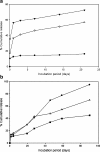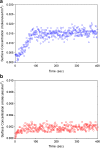Poly(ethylene glycol)-modified proteins: implications for poly(lactide-co-glycolide)-based microsphere delivery
- PMID: 19199044
- PMCID: PMC2664882
- DOI: 10.1208/s12248-009-9081-8
Poly(ethylene glycol)-modified proteins: implications for poly(lactide-co-glycolide)-based microsphere delivery
Abstract
The reduced injection frequency and more nearly constant serum concentrations afforded by sustained release devices have been exploited for the chronic delivery of several therapeutic peptides via poly(lactide-co-glycolide) (PLG) microspheres. The clinical success of these formulations has motivated the exploration of similar depot systems for chronic protein delivery; however, this application has not been fully realized in practice. Problems with the delivery of unmodified proteins in PLG depot systems include high initial "burst" release and irreversible adsorption of protein to the biodegradable polymer. Further, protein activity may be lost due to the damaging effects of protein-interface and protein-surface interactions that occur during both microsphere formation and release. Several techniques are discussed in this review that may improve the performance of PLG depot delivery systems for proteins. One promising approach is the covalent attachment of poly(ethylene glycol) (PEG) to the protein prior to encapsulation in the PLG microspheres. The combination of the extended circulation time of PEGylated proteins and the shielding and potential stabilizing effects of the attached PEG may lead to improved release kinetics from PLG microsphere system and more complete release of the active conjugate.
Figures




Similar articles
-
Adsorption of poly(ethylene glycol)-modified ribonuclease A to a poly(lactide-co-glycolide) surface.Biotechnol Bioeng. 2005 Jun 30;90(7):856-68. doi: 10.1002/bit.20481. Biotechnol Bioeng. 2005. PMID: 15841471
-
Recombinant human erythropoietin (rhEPO) loaded poly(lactide-co-glycolide) microspheres: influence of the encapsulation technique and polymer purity on microsphere characteristics.Eur J Pharm Biopharm. 1998 May;45(3):295-305. doi: 10.1016/s0939-6411(98)00012-5. Eur J Pharm Biopharm. 1998. PMID: 9653634
-
Biodegradable polymeric microparticles for drug delivery and vaccine formulation: the surface attachment of hydrophilic species using the concept of poly(ethylene glycol) anchoring segments.Biomaterials. 1997 Sep;18(17):1153-61. doi: 10.1016/s0142-9612(97)00051-3. Biomaterials. 1997. PMID: 9259512
-
Microencapsulation of protein drugs for drug delivery: strategy, preparation, and applications.J Control Release. 2014 Nov 10;193:324-40. doi: 10.1016/j.jconrel.2014.09.003. Epub 2014 Sep 10. J Control Release. 2014. PMID: 25218676 Review.
-
PLGA/PLA-Based Long-Acting Injectable Depot Microspheres in Clinical Use: Production and Characterization Overview for Protein/Peptide Delivery.Int J Mol Sci. 2021 Aug 18;22(16):8884. doi: 10.3390/ijms22168884. Int J Mol Sci. 2021. PMID: 34445587 Free PMC article. Review.
Cited by
-
Prevention of benzyl alcohol-induced aggregation of chymotrypsinogen by PEGylation.J Pharm Pharmacol. 2011 Jun;63(6):800-5. doi: 10.1111/j.2042-7158.2011.01288.x. Epub 2011 May 3. J Pharm Pharmacol. 2011. PMID: 21585378 Free PMC article.
-
Injectable protease-operated depots of glucagon-like peptide-1 provide extended and tunable glucose control.Proc Natl Acad Sci U S A. 2013 Feb 19;110(8):2792-7. doi: 10.1073/pnas.1214518110. Epub 2013 Jan 28. Proc Natl Acad Sci U S A. 2013. PMID: 23359691 Free PMC article.
-
Glycosylation improves α-chymotrypsin stability upon encapsulation in poly(lactic-co-glycolic)acid microspheres.Results Pharma Sci. 2012;2:46-51. doi: 10.1016/j.rinphs.2012.08.001. Results Pharma Sci. 2012. PMID: 23419866 Free PMC article.
-
Poly(lactic-co-glycolic acid) devices: Production and applications for sustained protein delivery.Wiley Interdiscip Rev Nanomed Nanobiotechnol. 2018 Sep;10(5):e1516. doi: 10.1002/wnan.1516. Epub 2018 Mar 13. Wiley Interdiscip Rev Nanomed Nanobiotechnol. 2018. PMID: 29536634 Free PMC article. Review.
-
Effect of mPEG-PLGA on Drug Crystallinity and Release of Long-Acting Injection Microspheres: In Vitro and In Vivo Perspectives.Pharm Res. 2024 Jun;41(6):1271-1284. doi: 10.1007/s11095-024-03717-y. Epub 2024 Jun 5. Pharm Res. 2024. PMID: 38839720
References
-
- Harris J. M., Chess R. B. Effect of PEGylation on pharmaceuticals. Nat. Rev. 2003;2:214–221. - PubMed
-
- Hutton P., Cooper G., James F. M., James F. M., III, Butterworth J. F., IV . Anaesthesia: Fundamental principles and practice. London: Informa Health Care; 2002.
-
- Genentech, http://www.gene.com/gene/products/information/opportunistic/nutropin-aq/.... Accessed various dates.
-
- FDA, http://www.fda.gov/MEDWATCH/SAFETY/2004/oct_PI/Nutropin_PI.pdf. Accessed various dates.
-
- Pfizer, http://www.pfizer.com/files/products/uspi_somavert.pdf. Accessed various dates.
Publication types
MeSH terms
Substances
LinkOut - more resources
Full Text Sources
Other Literature Sources
Miscellaneous

